6 Simple Strength Routines That Reverse Muscle Loss After 45
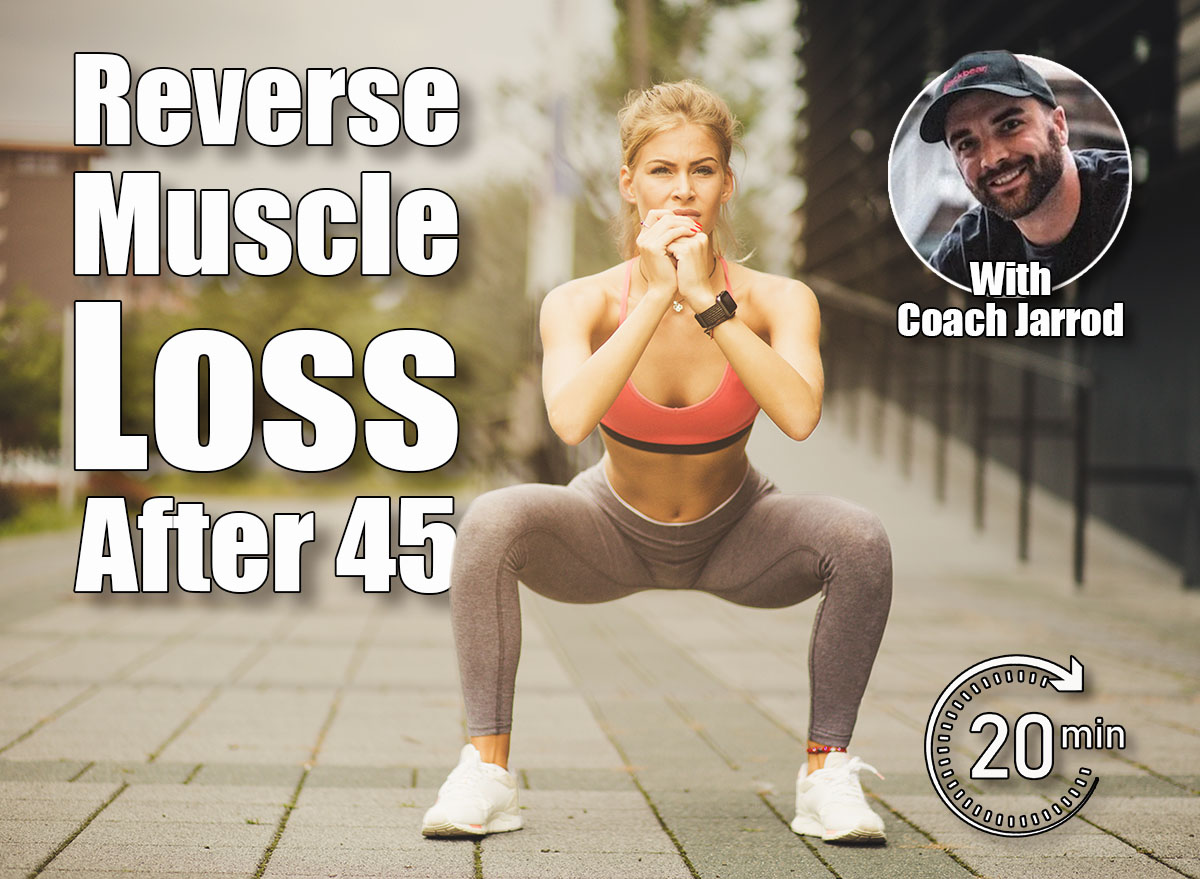
After 45, muscle mass naturally starts to decline at a faster rate, a process known as sarcopenia. The result isn’t just less strength in the gym. It can lead to weaker joints, slower recovery, and everyday tasks, such as climbing stairs or carrying groceries, becoming more challenging than they should be. The good news is that targeted strength training is one of the most effective ways to fight this loss, and the earlier you make it part of your routine, the longer you hold on to muscle and vitality.
The key is choosing movements that work with your body, not against it. That means simple routines that challenge your muscles through full ranges of motion, reinforce balance and posture, and replicate the way you actually move in daily life. You don’t need hours in the gym or advanced equipment. What you need are consistent, smartly designed routines that focus on strength, power, and stability.
The following six routines are built to cover all bases. Each one highlights a different piece of the muscle-maintenance puzzle—upper body, lower body, core, power, carrying strength, and total-body mobility. Practice these consistently, and you’ll not only fight muscle loss but build a foundation of strength that carries into every area of life.
6 Strength Routines That Reverse Muscle Loss After 45
The Push-Pull Power Workout
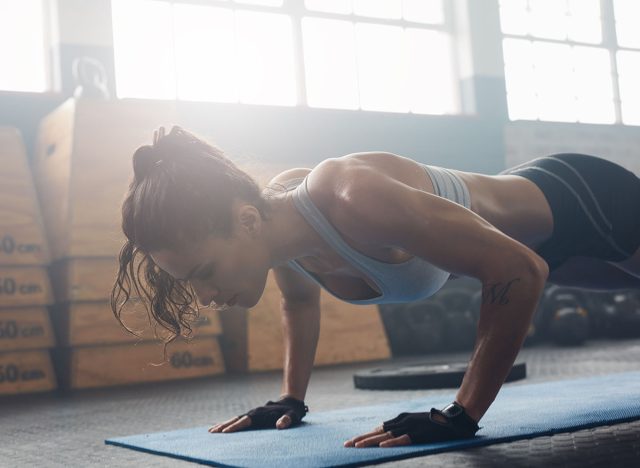
This workout balances pressing and pulling strength, which is critical after 45. Many adults develop rounded shoulders and weak upper backs from sitting and working at a desk. Training both push-ups and rows ensures strong chest and shoulders while reinforcing posture, balance, and joint stability.
What you need: Suspension trainer, sturdy bar, or countertop for rows. Optional mat for push-ups. About 15 minutes.
The Routine:
- Push-Ups (3–4 sets of 8–12 reps)
- Bodyweight Rows (3–4 sets of 8–12 reps)
- Push-Ups (repeat for balance)
- Bodyweight Rows (repeat for balance)
Directions: Alternate push-ups and rows for 3–4 rounds. Rest 45–60 seconds between moves.
How to Do It:
- Push-Ups
- Place your hands slightly wider than shoulder-width.
- Step back into a plank, keeping your body straight.
- Lower your chest toward the floor.
- Press back up to full extension.
- Bodyweight Rows
- Hold a suspension trainer or grab a bar.
- Lean back with arms straight.
- Pull your chest toward your hands.
- Lower with control and repeat.
- Push-Ups (Round 2)
- Perform another set at the same or reduced incline if fatigued.
- Bodyweight Rows (Round 2)
- Perform another set, keeping your core tight.
Best Variations: Incline push-ups, dumbbell bench press, banded rows, one-arm dumbbell row.
Form Tip: Engage your core throughout both moves to prevent sagging hips or arching back.
The Squat & Step Workout
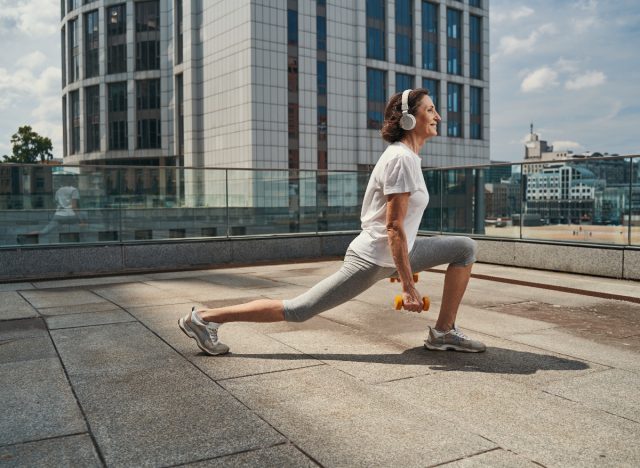
Lower-body strength is the foundation for balance and mobility. After 45, weakness in the legs accelerates muscle loss, fall risk, and joint issues. This workout targets the quadriceps, gluteals, and hamstrings while reinforcing everyday skills such as standing up, walking, and climbing stairs.
What you need: A sturdy step, bench, or box. Optional dumbbells for extra load. About 15–20 minutes.
The Routine:
- Bodyweight Squats (3 sets of 10–12 reps)
- Step-Ups (3 sets of 8–10 reps each leg)
- Split Squats (3 sets of 8–10 reps each leg)
- Bodyweight Squats (finish with 2 sets of 12–15 reps)
Directions: Perform all exercises as a circuit. Rest 60–75 seconds between rounds.
How to Do It:
- Bodyweight Squats
- Stand with feet shoulder-width apart.
- Push hips back and bend knees.
- Lower until thighs are parallel.
- Drive through your heels to stand tall.
- Step-Ups
- Place one foot on a bench or step.
- Push through the front heel to stand tall.
- Lower under control.
- Switch legs each rep or after a complete set.
- Split Squats
- Step one leg forward, one back.
- Bend both knees to lower into a lunge.
- Keep torso tall.
- Press through the front heel to stand.
- Bodyweight Squats (Finisher)
- Repeat squats at a slightly faster tempo.
Best Variations: Goblet squats, weighted step-ups, and Bulgarian split squats.
Form Tip: Keep knees aligned over toes and avoid letting them cave inward.
RELATED: 5 Bodyweight Exercises That Torch Belly Fat Without Getting on the Floor After 50
The Core Stability Flow
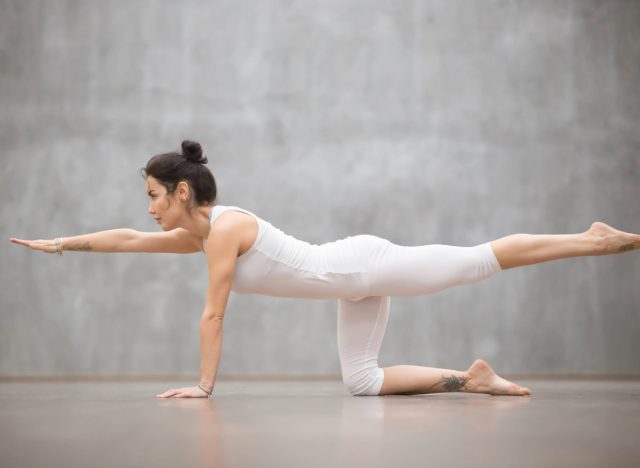
Core strength is about more than abs. It’s the foundation for protecting your spine and transferring power between your upper and lower body. This workout targets the deep stabilizers to reduce back pain, improve posture, balance, and athletic performance.
What you need: A Mat or soft surface. About 10–15 minutes.
The Routine:
- Plank (3 sets of 20–45 seconds)
- Dead Bugs (3 sets of 8–10 reps each side)
- Bird Dogs (3 sets of 8–10 reps each side)
- Side Plank (2–3 sets of 20–30 seconds each side)
Directions: Perform exercises in order, resting 30 seconds between sets.
How to Do It:
- Plank
- Place elbows under shoulders.
- Extend legs into a straight line.
- Hold without letting hips sag.
- Dead Bugs
- Lie on your back, arms extended.
- Lower the opposite arm and leg.
- Keep your core braced.
Return and switch sides.
- Bird Dogs
- Begin on all fours.
- Extend opposite arm and leg.
- Pause briefly, then switch.
- Side Plank
- Lie on your side with your elbow under your shoulder.
- Lift hips until body forms a straight line.
- Hold steady.
Best Variations: Stability ball rollouts, hollow holds, mountain climbers.
Form Tip: Brace your abs as if preparing for impact.
The Carry & Lift Workout
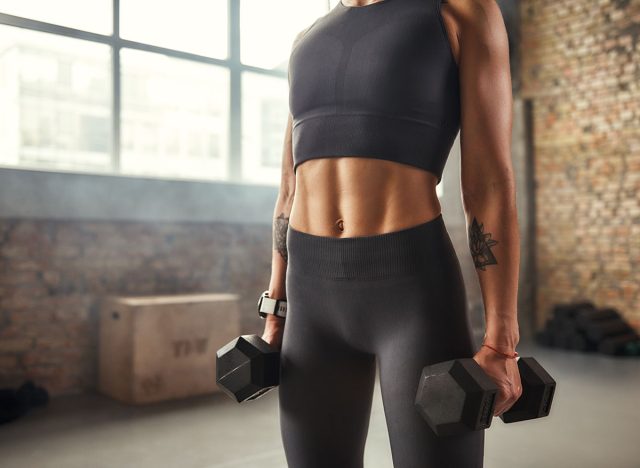
Carries and lifts mimic real-life movements—picking up groceries, moving furniture, holding luggage. This routine strengthens your grip, back, and core, building resilience and independence as you age.
What you need: Dumbbells, kettlebells, or any heavy household items. About 15 minutes.
The Routine:
- Farmer’s Carries (3–4 sets of 30–40 steps)
- Suitcase Carries (3 sets of 20–30 steps each side)
- Dumbbell Deadlifts (3 sets of 10 reps)
- Farmer’s Carries (2 sets of 40 steps as a finisher)
Directions: Perform carries for distance, resting briefly, then move into deadlifts. Finish with a carry challenge round.
How to Do It:
- Farmer’s Carries
- Hold dumbbells at your sides.
- Stand tall and walk forward 30–40 steps.
- Keep shoulders pulled back.
- Suitcase Carries
- Hold one dumbbell in one hand.
- Walk 20–30 steps without leaning.
- Switch hands and repeat.
- Dumbbell Deadlifts
- Stand with dumbbells in front of your thighs.
- Hinge at the hips and lower weights to mid-shin.
- Stand tall, squeezing glutes at the top.
- Farmer’s Carries (Finisher)
- Repeat the carry with a focus on distance.
Best Variations: Overhead carries, rack carries, trap bar deadlifts.
Form Tip: Keep core tight and avoid leaning to one side on suitcase carries.
The Explosive Youth Builder
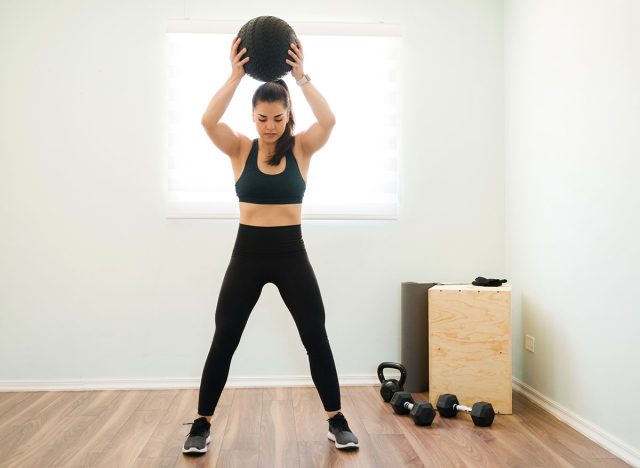
Power fades faster than strength with age. Training explosively helps preserve fast-twitch muscle fibers, which support balance, reaction speed, and athletic movement. This workout safely develops power using bodyweight and light resistance.
What you need: Medicine ball or kettlebell. About 15–20 minutes.
The Routine:
- Medicine Ball Slams (3 sets of 8–10 reps)
- Squat Jumps (3 sets of 6–8 reps)
- Kettlebell Swings (3 sets of 10–12 reps)
- Medicine Ball Slams (2 sets of 10 reps as finisher)
Directions: Perform each move explosively with full effort. Rest 90 seconds between sets to maintain quality.
How to Do It:
- Medicine Ball Slams
- Hold the ball overhead.
- Drive it into the ground as hard as possible.
- Catch on the bounce and repeat.
- Squat Jumps
- Perform a bodyweight squat.
- Explode upward into a jump.
- Land softly with bent knees.
- Kettlebell Swings
- Hold the kettlebell with both of your hands.
- Hinge at the hips and swing the weight to chest level.
- Use hips, not arms, to drive motion.
- Medicine Ball Slams (Finisher)
- Repeat with maximum effort.
Best Variations: Box jumps, rotational throws, broad jumps.
Form Tip: Focus on speed and crisp movement, not heavy weight.
The Full-Body Flow

Strength and mobility must work together as you age. This workout combines multiple movement patterns into one flow, challenging stability while building muscle. It teaches your body to move as a unit instead of in isolated parts.
What you need: A kettlebell, dumbbell, or just bodyweight. About 20 minutes.
The Routine:
- Half Turkish Get-Up (3 sets of 2–3 reps each side)
- Overhead Press from Lunge (3 sets of 8–10 reps each side)
- Lunge-to-Rotation (3 sets of 8 reps each side)
- Full Turkish Get-Up (3 sets of 2 reps each side)
Directions: Move smoothly through each exercise. Rest 90 seconds between sets.
How to Do It:
- Half Turkish Get-Up
- Lie on your back with the weight overhead.
- Roll to your elbow, then your hand.
- Return to the floor with control.
- Overhead Press from Lunge
- Step into a lunge.
- Press weight overhead.
- Lower and repeat.
- Lunge-to-Rotation
- Step forward into a lunge.
- Rotate your torso over the front leg.
- Return and switch sides.
- Full Turkish Get-Up
- Begin on the floor with the weight overhead.
- Roll to your side, rise to standing.
- Reverse the steps to return to the ground.
Best Variations: Dumbbell thruster, side-bend lunge, half get-up.
Form Tip: Keep your eyes on the weight during the get-up for balance and safety.
Final Takeaway: How to Train for Muscle Longevity After 45

Muscle doesn’t fade overnight. It slips away little by little if you don’t challenge it. The good news is you don’t need complex programming to turn the tide. What matters most is consistency, structure, and a plan that balances effort with recovery. By following simple routines like the ones above, you can build a weekly training rhythm that restores strength, maintains muscle, and keeps you feeling younger than your age.
Action Steps:
- Train 2–3 times per week with a mix of these routines.
- Rotate focus: upper body one day, lower body another, then full-body.
- Prioritize quality over quantity. Good form beats heavy weight every time.
- Retest your strength every 6–8 weeks by measuring reps, holds, or distance carried.
- Support your training with protein-rich meals, proper recovery, and good sleep.
Strength training keeps you strong, capable, and confident in every area of life.
Looking for easy ways to lose fat? Here’s How Long Your Walking Workout Should Be To Shrink Belly Fat.